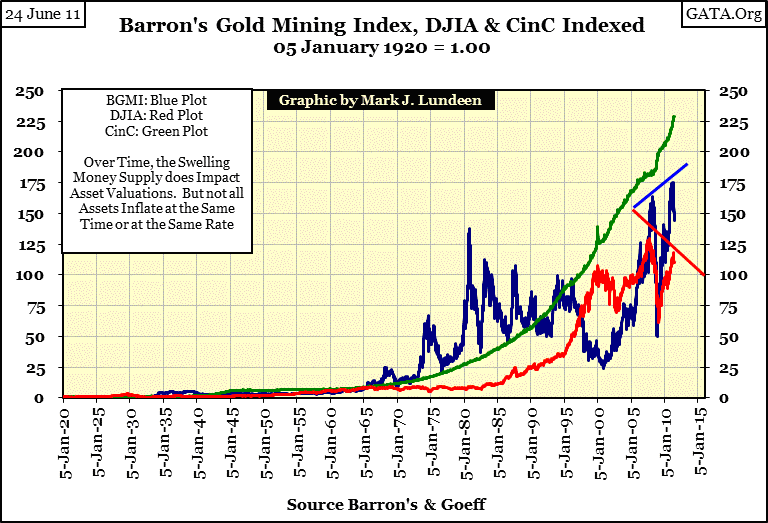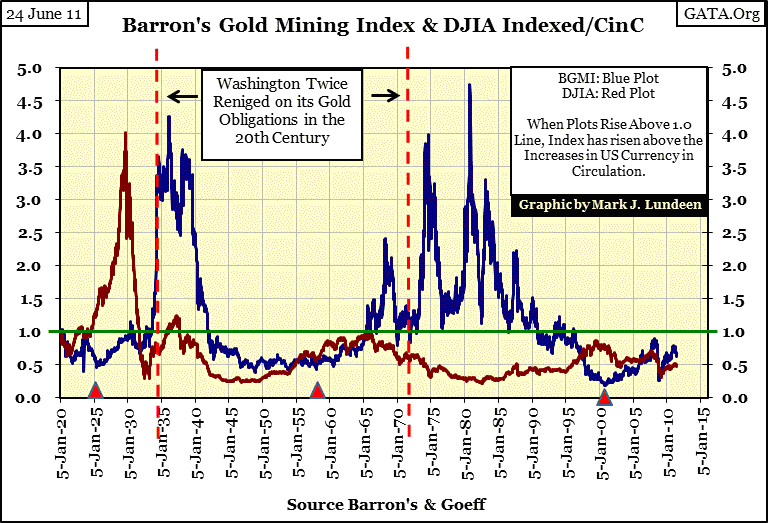Dow Jones, Barron's Gold Mining Index & CinC
Everyone's been asking what's wrong with the mining shares? Well, since Doctor Bernanke and Treasury Secretary Geithner no longer return my calls, I can only offer you my opinion. I think the "policy makers" are sitting on the miners via naked shorting of their shares.
I keep thinking of all the "new tools" Doctor Bernanke and Secretary Geithner asked for, and got from the Congress in October 2008. These congressional hearings were conducted during the market meltdown in a presidential election year, with the election just weeks away. To once again see "stability" restored in the markets, what could Doctor Bernanke and Secretary Geithner have asked for, that Congress could give them? Well, I ask myself; what was the problem they were trying to solve? Prices in the stock market were going the wrong way; down instead of up.
Prices after all are only the intersection of the supply and demand curves. If the "policy makers" wanted the prices in the stock market to go back up, reducing the supply of common stocks would greatly support the market. With the obscene sums of inflation the government has spent in "stimulus and stability operations", it's only logical for them to rout a significant amount of these funds in direct support of the stock market, to purchasing shares, with the intent of reducing the supply of shares trading in the stock market. I suspect that currently, the Fed and its banking system have purchased, and are now holding a large percentage of America's common stock in off shore accounts, far away from the floor of the NYSE.
The "policy makers" can't approve of any aspect of the precious metals market attracting the attention of investors. Seeing the XAU or the HUI increasing is just as bad as having the Dow Jones decreasing. So, from a "policy" stand point, exactly how does one go about depressing the price of something? The only way I can think of is by increasing the supply of the item. Accusations of "naked shorting" the mining shares have been around for years, and I take them very seriously.
"Injecting" additional shares of mining companies, via naked shorting (counterfeit shares created from nothing by Wall Street just as the Fed counterfeits dollars it needs for its various activities), into the market at critical junctures would increase supply, and so dampen "speculative excesses" in the precious metal miners. Doing this would be totally illegal, as the number of shares trading in the market are supposed to be set by the company's shareholders. However, it's only logical that the masters of a monetary system being inflated to infinity would rather not see the prices of gold and silver mining shares rising faster than increases in their money supply. So, I'm very suspicious of mining shares lagging the price of the metals they mine.
However, this is all a theory, though a compelling one. But I can't chart theories, so, I thought maybe it's time to revisit my charts on the Dow Jones, Barron's Gold Mining Index (BGMI) and US Currency in Circulation (CinC).
When working on something electrical or mechanical, things are basically simple. If a light is on, so must be the switch that controls it. If a car is accelerating, the driver is depressing the gas pedal. But economics and investing are not that simple, as changing prices are the result of billions of individual decisions made in the market place. So central bankers can "stimulate" the economy with "injections of liquidity", but only if the people spend the money as "policy" would have them to. However, sometimes they don't.
We are told how rising "inflation" always hurts financial assets; that rising "inflation" is always good for gold and silver. But inflation is not that simple! A more accurate description of inflation's effects on the markets would be to say that when "liquidity injected" (increases in CinC) into the economy flows into consumer prices, financial assets typically decline as gold and silver rise in price with interest rates. But when "liquidity injected" (CinC) flows into financial assets, consumer prices stagnate as gold and silver decline with interest rates. Why CinC at times flow into this or that area of the economy is always dependent on billions of little economic decisions made by people spending the freshly issued dollars flowing from the Federal Reserve.
The inflation flooding from the Federal Reserve since 1920 is very evident in the charts below, as is the counter-cyclical nature of the bull and bear markets in the Dow Jones and the BGMI. We can see exactly where the Fed's "liquidity" (CinC's green plot) is flowing by following these bull markets. Those times when financial assets are in a bull market, the Dow Jones (red plot) is rising up toward the green CinC plot. These bull markets are purely inflationary events, but market commentators frequently attribute these periods to economic growth. But those times when consumer prices are on the rise, the Dow Jones was struggling, but the BGMI was enjoying a bull market.

What is actually happening is this; the Fed inflates financial assets to the point where valuations become unstable, which results in a collapse in bond and stock prices. Money then exits the stock and bond markets, looking for a safe haven. More often than not, money flowing from deflating financial assets finds itself moving into commodities and mining stocks. So, one can think of bull markets in the BGMI, as the inflationary consequence of deflating financial assets, and the reason why bull markets in the Dow Jones and the BGMI have been counter-cyclical to each other since 1920. This inflationary cycle is as simple as: the Fed inflates financial assets until the bubble will hold no more, nature calls, and the Dow Jones then deflates into the inflating Barron's Gold Mining Index.
Notes for my charts: the BGMI only goes back to 1938, but Homestake Mining (a gold miner) was one of its two companies. So from 1920 to 1938, BGMI data is actually the price of Homestake Mining. Barron's began publishing weekly values of CinC in their 23 February 1931 issue. The gap in CinC for 1920 to 1931 was filled with data from Milton Friedman and Anna Schwartz's monetary history of the US.
Using the data as published (chart above) doesn't reveal much of interest before 1965, but it clearly shows that from 1965 to present, the BGMI (blue chip gold mining companies) was a much better investment than the Dow Jones. It's also remarkable that a dollar invested in the companies comprising the BGMI in 1965 maintained its purchasing power, in terms of rising CinC, until 1995! Also, since 1929 (chart below) the Dow Jones, which is a proxy for American blue-chip stocks, has more often than not, failed to protect their owners from the ravages of inflation.
The chart below looks nothing like the one above, but they were created using the same data. The Dow Jones and the BGMI plots below are ratios to the green CinC plot above. The chart below displays the performance of the Dow Jones and the BGMI indexed to CinC inflation. But the main thing to notice in the charts above and below is how the Dow Jones and the BGMI have been counter-cyclical to each other for many decades.

Since 2002, both the Dow Jones and the BGMI have been rising, but are they still counter-cyclical to each other? I'd say YES! Again, I must remind my readers that we are not discussing light bulbs and sports cars, but market prices set by fickle buyers and sellers of assets. Look at the BGMI from 1925-37; it too was rising with the Dow Jones during the Roaring 20s, but with little fanfare. And the Dow Jones also rose with the BGMI from 1932-37. However, the chart above tells us where the big money was flowing.
Look at these plots during the credit crisis crash. The BGMI saw a deeper bottom than the Dow Jones, but has since gone on to new highs. Unlike the Dow Jones, the gold miners are currently showing some signs of enthusiasm. If it wasn't for the trillion dollar machinations of high officials in the Federal Government and Wall Street, would the Dow Jones have made new highs in 2007? I seriously doubt it.
Currently, natural forces present in the markets are attempting to deflate the bond and stock markets, as well as valuations in the commercial and residential real estate markets of their inflationary excesses of the past 30 years. "Injected liquidity" into financial assets from past bull markets eventually drains away. This recycled "liquidity" spilling out of deflating financial assets has provided the inflationary rocket fuel for bull markets in gold, silver and mining shares in the past. As prices in the stock and bond markets go lower and lower, the BGMI, gold and silver will have more fuel to go higher and higher.
A remarkable fact shown clearly in the chart above, is that the * ONLY * Dow Jones bull market that ever provided substantial, inflation adjusted returns to investors was the 1925-29 bull market. However, in the 91 years of market history displayed above, the BGMI returned substantial returns to investors in every one of its bull markets. However, these market movements can take many years. So, I'm not surprised that the BGMI (blue plot) in the chart above is not yet far above the green 1.0, CinC break even line. Before the bull market in precious metals and their mining shares is over, there is good reason to believe that the BGMI will exceed CinC inflation again. It's one of those better-than-house-odds things we should all be looking for.
[email protected]
















